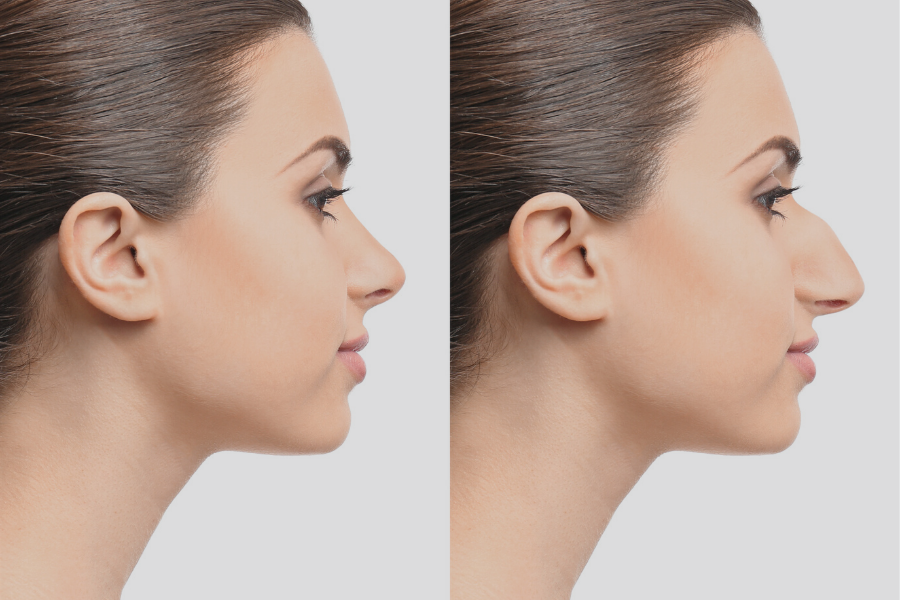
WHAT IS A RHINOPLASTY?
A rhinoplasty is commonly referred to as a nose job surgery. There are two types of plastic surgeries specifically for nose jobs – reconstructive and cosmetic. Whether you’re seeking corrective surgery for basic functionality of your nasal passage or an aesthetic preference, a board certified plastic surgeon can help.
Nose Surgery (Rhinoplasty)
Rhinoplasty enhances facial harmony and the proportions of your nose. It can also correct impaired breathing caused by structural defects in the nose. Rhinoplasty surgery can change:
- Nose size in relation to facial balance
- Nasal tip that is enlarged or bulbous, drooping, upturned or hooked
- Nose profile with visible humps or depressions on the bridge
- Nostrils that are large, wide, or upturned
- Nose width at the bridge or in the size and position of the nostrils
- Nasal asymmetry
During your rhinoplasty recovery, a splint and/or packing will likely be placed inside your nose and a splint or bandages placed on the outside to support and protect the new structures during initial healing. While initial swelling subsides within a few weeks, it may take up to a year for your new nasal contour to fully refine. You may notice gradual changes during this time in the appearance of your nose as it refines to a more permanent outcome. Swelling may come and go and worsen in the morning during the first year following your rhinoplasty surgery.
- Dr. Garza will give you specific instructions that may include:
- How to care for the surgical site
- Medications to apply or take orally to aid healing and reduce the potential for infection
- Specific concerns to look for at the surgical site or in your general health
- When to follow up.
Nose Job FAQs
Who is a good candidate for rhinoplasty?
A good rhinoplasty candidate is in good overall health, has realistic expectations about surgery results, and wishes to improve the appearance or function of their nose.
What is the recovery process like?
Nose job recovery typically involves swelling and bruising around the nose and eyes, which can last for several weeks. Patients should avoid strenuous activities and keep their head elevated to minimize swelling. Full recovery can last several months, after which the final surgery results will show.
Are there any risks with rhinoplasty?
As with any surgical procedure, rhinoplasty carries certain risks, including infection, bleeding, adverse reaction to anesthesia, and unsatisfactory aesthetic results. Discuss these risks with your surgeon and carefully follow their pre- and post-operative instructions to reduce risk.
How long does a nose job last?
Rhinoplasty results are typically long-lasting, but keep in mind that the nose cartilage will continue to grow as you age. Additionally, a nose injury or trauma could affect the results of the surgery.
Can I combine rhinoplasty with other procedures?
Yes, rhinoplasty can be combined with other facial plastic surgery procedures, such as chin augmentation or eyelid surgery, to achieve overall facial harmony and balance.
How much does rhinoplasty cost in Tennessee?
Usually, a nose job will cost between $2,500 – $8,000 in Tennessee. The cost will vary depending on your procedure. Consult your surgeon for an estimate, and ask us about affordable financing options to know how much you will pay.
Can insurance cover a nose job?
Rhinoplasty is typically an elective surgery, so insurance will not cover it. However, if you can prove that you need the surgery for medical reasons, like a breathing problem, health insurance may cover a portion of the surgery’s cost.
What can rhinoplasty fix?
A nose job can fix a number of issues, including reducing or increasing the size of the nose, reshaping the tip or bridge, correcting asymmetry, narrowing nostrils, or improving breathing problems.
Can you fix snoring with a nose job?
A nose job can fix snoring if the snoring is due to a structural problem in the nose, like a deviated septum. Your doctor will be able to tell you if a nose job can fix your snoring or if you need an alternative treatment.
Rhinoplasty in Nashville
If you’re interested in a nose job in Nashville, schedule a consultation with Garza Plastic Surgery today! Double board-certified plastic surgeon Dr Garza will guarantee you reach your aesthetic goals.
